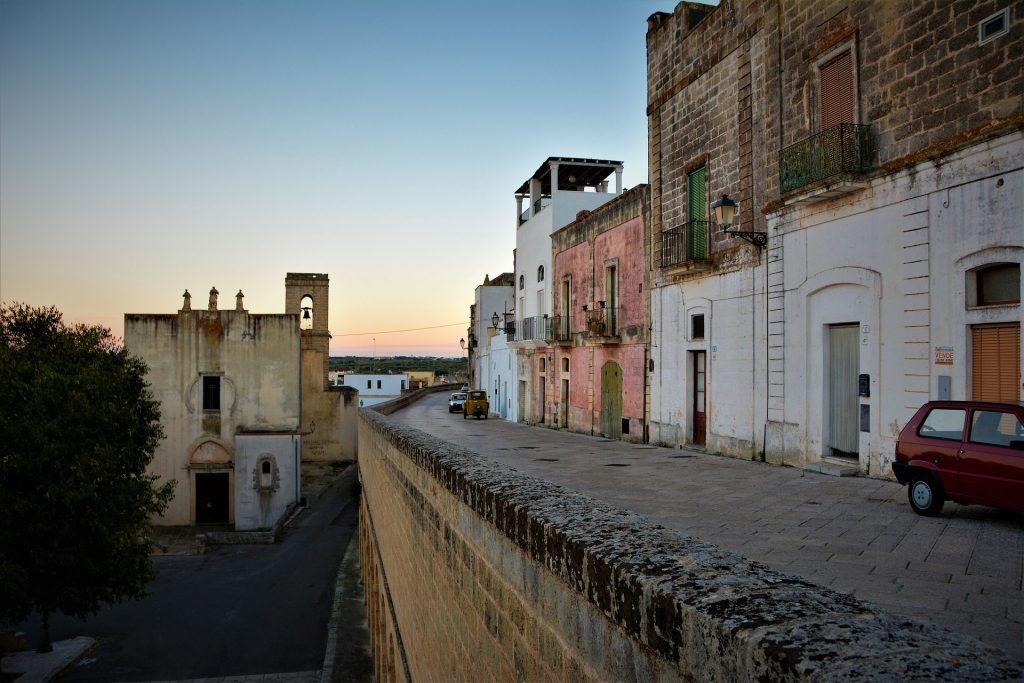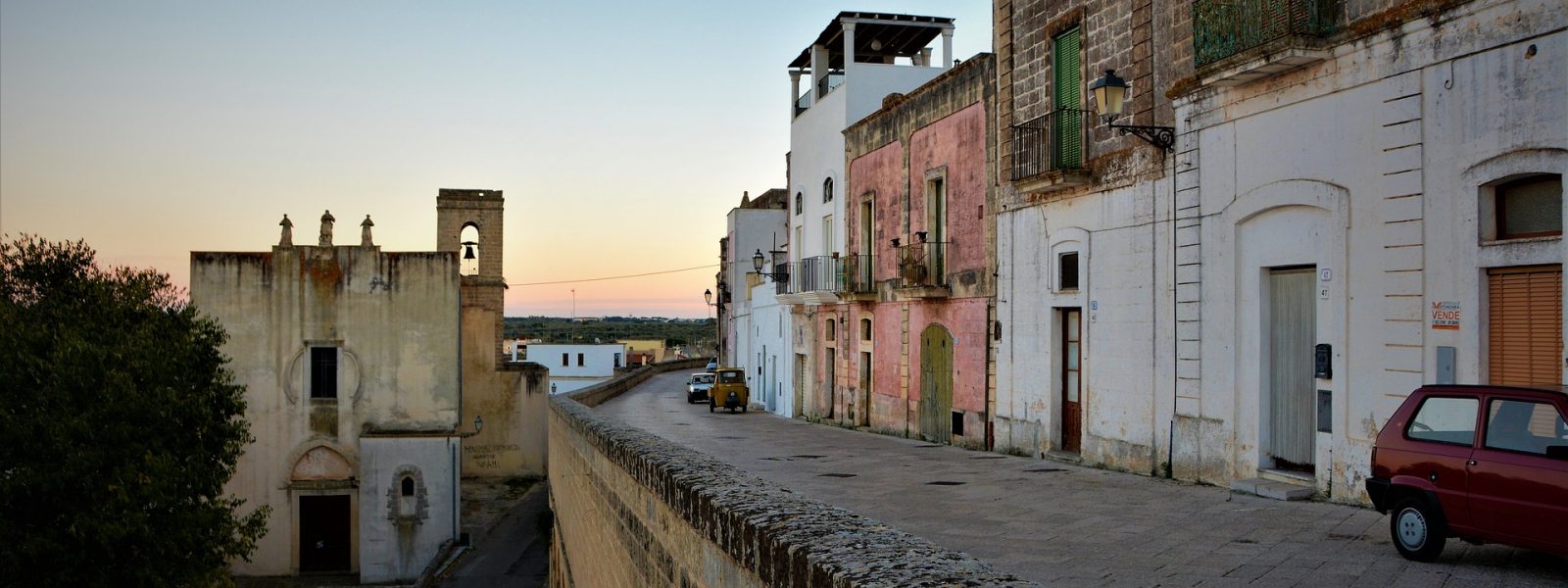Specchia is an Italian town of 4.766 inhabitants in the province of Lecce in Puglia, located in the lower Salento, 53 km from the provincial capital.

The name of the town derives from the Latin specula, artificially raised place. In fact, it originates from the “specchie”, conical-shaped stone heaps that the Messapi used as a sighting and defence point or as a territorial demarcation system. In some documents up to the 18th century the name of Specla Presbiterorum is reported, according to Mons. G. Ruotolo the name is due to the fact that the town belonged mainly to regular and secular priests.
In the Middle Ages, it also appears as Specla de Amygdalis, a term later transformed into Specchia Mendolia, with reference to the almond trees widespread in the area. The legend of the foundation of Specchia by the Roman matron Lucrezia Amendolara is also connected here.
Walking through the perfectly preserved historic center of Specchia one gets the feeling that time has stopped. The narrow alleys, the dry-stone walls and the stairways that create suggestive ups and downs make Specchia a place suspended in a past that has never been lost.
The historic core of the village has an unmistakable medieval soul, which can be deduced from the very layout of the city, built around a defensive building in an elevated position. While the remains of the ancient walls of Specchia can still be observed here and there, it is going up towards its highest part that you come to Piazza del Popolo, a lovely open space that sees some of the most elegant buildings in the area appear.
Specchia is a real historical pearl in the heart of Salento: it is part of the club “The most beautiful villages in Italy”, and in 2013 it received the recognition as “Jewel of Italy”.
Let’s start our discovery of this gem of Puglia!
Jewels of Puglia
Risolo Castle
Risolo Castle, located in the heart of the historic center, is a sixteenth-century building. The site, by virtue of its strategic position, was occupied since the Middle Ages by a castle. All around, a mighty wall protected the small town.
In the first half of the 15th century, the city was conquered and destroyed, as part of the numerous and bloody battles for the conquest of the Kingdom of Naples. Only towards the end of the fifteenth century, the village was repopulated and equipped again with a castle. The current building is the result of a series of alterations that took place between the 15th and 18th centuries. In the main square of Specchia, Piazza del Popolo, stands the Risolo Castle, a fortified building built in the 16th century. Initially, the Risolo Castle was an isolated structure, later it was later incorporated into other buildings.
Two tall square towers emerge on the corners of the ancient quadrangular structure. The eastern front overlooks the Piazza del Popolo. The front door is dominated by the coat of arms and two statues. Belonging to various important families, the Risolo Castle was transformed into a marquis palace by the Protonobilissimi family (hence the name Protonobilissimo Castle), marquesses of Specchia during the sixteenth and seventeenth centuries. Fortified quadrangular structure of the late fifteenth century built in tuff, a mixture of lime and local red earth, initially isolated and then connected to other buildings between which two high square towers emerge.
After the destruction of a previous castle and the city walls between 1434 and 1435 by the troops led by Giacomo Caldora ally of Luigi Terzo D’Angio ‘and rival of the local baron Giacomo Del Balzo, in turn sided with the prince of taranto Giovanni Del Balzo Orsini and with Alfonso D’aragona – it was the Del Balzo family who, in the last decades of the 15th century, provided for the new fortification of Specchia.
The new fortified structure underwent non-marginal changes between 500 and 600 and in 700 it was transformed into a residential building by the Marquis Protonobilissimi, precisely Desiderio Protonobilissimo, prince of Muro Leccese and his wife Margherita Trane, holder of the fief of Specchia after the death of Father Ottavio , are represented by the two statues which, divided by a coat of arms, dominate the ashlar door which forms the entrance to the castle. And its main facade appears today in its eighteenth-century form.
Currently the building, subjected to a restoration that has preserved the characteristics of a fortified palace, becomes the location of some exhibitions and exhibition events, conferences, and civil wedding celebrations.
Palazzo Ripa
The baronial palace dating back to the seventeenth century was built close to one of the ancient city gates (Porta Leuca).
In 1900, the owners of the building ordered the construction of the portico by purchasing the necessary space from the Municipality, which allowed the state bequest, reserving the underlying loggia for public use, which has become a habitual meeting place. In 1959, the palace was sold by the heirs of Baron Ripa to dr. Antonio Longo.
Palazzo Ripa is an important historical building that bears the name of the Conti family who owned it Ripa.
It was built in the 17th century next to Porta Leuca, one of the main access routes to the city center.
It is a rectangular building with a crenelated top and a small lateral turret that was added in the eighteenth century.
The portico does not date back to either of the two periods mentioned, but was added in 1900 at the request of the count’s heirs, today it is one of the main meeting points for young people in the city as the state property is for public use and not just private.
At the beginning of the sixties the palace was sold by the last heirs of the family and was bought by Dr. Longo who is still the current owner.
Underground Oil Mills
In Specchia, you can admire some underground oil mills excavated between the fifteenth and nineteenth centuries, important historical evidence of the production of olive oil in the past centuries.
The Scupola underground oil mill is located in the G. Carducci court, not far from Piazza del Popolo, in the center of the town of Specchia.
It consists of two different environments. The first, excavated in the tuff around the fifteenth century, retains a millstone used in the pressing tank, four “Genoese” presses and the relative settling tanks. The second room, dug around the seventeenth century, instead preserves three other millstones, with the relative “calata wells”, eight “Calabrese” presses and other settling tanks. In the perimeter of the entire mill, it is also possible to see several closed rooms used as deposits for the olive harvest or as resting places for workers.
In Specchia, it is also possible to visit the underground oil mill in via Perrone and the oil mill of the Convent of the Black Franciscans, built between the 9th and 16th centuries.
The underground oil mills are a classic testimony of the olive culture in Salento, with underground structures that still represent one of the most significant examples of industrial archaeology in these parts today.
Built from the fifteenth to the nineteenth century, the underground oil mills of Specchia were obtained from tuff and Lecce stone, with a floor level 3-5 meters lower than the road surface. Among the various oil mills Scupola, Cicca, Perrone, Franciscani Neri and others. These structures were built underground for the economic convenience of the excavation compared to the surface construction and for the temperature, necessary to separate the bilge water from the olive oil.
In Specchia, as in the rest of Salento, the mills were built in the XV – XIX centuries, underground and partially semi-underground, they were obtained in calcarenite banks of” tuff “or” Lecce stone “. The walking surface is three to five meters lower than the road or ground level.
It is assumed that the reasons for which the mills were built underground were of two types, the first of an economic nature, as the ease of excavation made the work more convenient as opposed to its construction on the surface; the second is of a technical nature, in fact, to facilitate the separation of the bilge water from the olive oil, it was necessary to maintain a constant temperature that was around 19/20 degrees, also for this reason it was preferred to orient the entrance towards the South , to shelter from the north wind.
Church of Sant’Eufemia
The Church of Sant’Eufemia is a sixth century church in the current town of Specchia, in the province of Lecce.
The building, with a longitudinal plan, oriented according to the East-West axis, on the outside presents, on the facade, a gabled shape with a large mullioned window with a truncated pyramidal capital on which a lobed cross is carved, and a portal with round arch while the rear part is characterized by a quadrangular apse in which two large windows open.
Inside, there are the remains of four series of triple arches supported variously by columns and pillars that were to divide the interior space into three naves. This particular architectural solution has led scholars to hypothesize a connection with other buildings of the Lombard age present in other Italian regions.
The facade faces west and has a double sloping, in the center it is interrupted by a portal surmounted by a round arch.
One of the most graceful and elegant elements of the entire building is the large mullioned window on the facade divided by a slender column with a truncated pyramidal capital softened by a lobed cross with equal arms, according to oriental iconography.
The interior has three naves enclosed in the center by monolithic columns that support round arches, which on the perimeter walls are supported by rough pillars, also monolithic.
What is surprising is the external irregularity of the spans both in relation to the axis of the church and in the distance between the columns, and as if that were not enough, the circumference of the columns also changes.
All this suggests that there were significant alterations, if not even that different parts of the current monument refer to two distinct moments.
The background is decorated with a large basin apse on which a mullioned window with round arches opens.
The Bema, raised above the Naos floor, contains the basilica altar, which the restorers have obtained from a column and a tombstone taken from the sepulchre adjacent to the church.
The floor is made of concrete and sand and allows stumps of columns to emerge in their original positions.
The roof is made of sheet metal and replaces the old wooden trusses, surmounted by a thick “cannizzo” plastered.
Above the metal reinforcement there is a layer of traditional Lucugnano tiles, as presumably it was originally.
The tombs, located on one side of the building and brought to light during the restoration work, are covered with earth.
Today some local stone slabs remain, while the finds have been moved elsewhere.
Convent of Black Franciscans
The construction of the church and convent of the Black Franciscans dates back to the first decades of the sixteenth century; in 1531 the Chapter of the Black Franciscans was held in the convent, as reported in an inscription.
The sacred building was renovated in the eighteenth century according to the baroque style of the time. On the wall to the left of the façade there is a high relief in Lecce stone probably depicting a member of the Protonobilissimo family who contributed to the construction of the church.
After the suppression of religious orders, the convent underwent numerous transformations and was used in 1885 as a female boarding school by the Daughters of Charity and in 1945 transformed into an orphanage. It was permanently closed in 1980
The Church and the annexed Convent of the Black Franciscans have a certain date, 1531, when the Chapter of the Black Franciscans took place in the convent, as reported in an inscription.
The church has a Gothic finish with ancient traces of a pointed arch on the door of the facade. The interior has a single nave. In 1532 the chapel dedicated to Santa Caterina d’Alessandria was built, set against the right side of the main facade.
The chapel is entirely frescoed with scenes from the life of Saint Catherine and her martyrdom and with depictions of the Medici Saints and the martyrdom of Sant’Agata.
From the choir, you enter an underground crypt of Basilian origin supported by 36 columns on four lines and containing traces of Byzantine frescoes.
The convent underwent further changes and in 1885 became a female boarding school by the Daughters of Charity.
Closed in 1980, it was restored in 2004 and is now a location for cultural events.
Church of the Presentation of the Blessed Virgin Mary
The mother church of the city of Specchia is also known as the Church of the Presentation of the Blessed Virgin Mary and it is one of the oldest buildings in the city. Its original nucleus dates back to the 15th century, but the current version is instead the work of a series of renovations carried out over the centuries.
The current Latin cross plan is the result of a series of alterations and extensions that took place between the seventeenth and twentieth centuries. In the beginning the building consisted of a single nave, with N-S orientation, corresponding to the current transept.
In 1605 the apse was built in exquisitely carved blocks of Lecce stone, as well as the altar of the Annunziata, also in Lecce stone, in Baroque style. In the eighteenth century the central nave and the facade were rebuilt.
After the Second World War, the two side naves were added to the central body with the consequent enlargement of the facade. The pillars are in Lecce stone with Venetian stucco, while the triumphal arches are decorated with floral motifs.
The bell tower was built in 1945 to replace the old bell tower of 1568 demolished because it was unsafe. The facade has an elegant portal surmounted by the effigy of San Nicola, protector of the town. On the sides, the two niches house the statues of the apostles Peter and Paul.
Some areas were in fact added in the seventeenth and eighteenth centuries. The plan is a Latin cross and the interior consists of a single nave that converges towards the central apse.
The apse is in exquisitely carved Lecce stone and the altar built with the same material is in Baroque style with some gold stuccoes and floral motifs.
Church of San Nicola di Mira
The Church of San Nicola di Mira probably dates back to the 11th century and constitutes, together with the nearby church of Sant’Eufemia, one of the medieval testimonies of the area. Oriented according to the south / east – north / west axis, which apparently differs from the custom of the Byzantine use, which arranged the apse of the church towards the east because from that point the sun rises, the church was consecrated and officiated according to the rite Greco-Byzantine until the end of the 17th century.
The precise location is the one from which the sun rises on the day in which the feast of the saint to whom the church is dedicated is celebrated. St. Nicholas is celebrated on December 6, a date remarkably close to the seasonal solstice, so the sun rises very low and only when it is almost south do its rays hit the altar. This explains this orientation and confirms its Byzantine origin.
Entirely restored in the sixteenth century and converted to the Latin rite, the church preserves a plaque which refers to its ancient origin. In 1587 it underwent radical transformations: the double-trussed roof was replaced with the current cross vault in ashlars of limestone (tuff), as can be seen from the keystone which also bears the coat of arms of Specchia after the date.
The layout of the church is extremely linear. The structure consists of a single nave with an apse; probably, the original apse was replaced with the current one, much larger. Six pillars draw the supporting structure and mark the internal space into two parts; on the main façade an elegant rose window is framed by a triangular pediment.
The church has been the subject of a recent restoration which has made it possible to recover a semi-fresco of the Madonna Enthroned with Child, from the sixteenth-century school, placed in one of the four niches present. In the other three niches, Byzantine-style icons were created. The main altar (1762) is in Lecce stone surmounted by the monolithic statue of San Nicola from a previous period.
The exterior is also in Baroque style with three access doors, one of which is central and two on the side. The bell tower was the latest addition to the complex and dates back to 1945 and was erected to replace the ancient bell tower of the sixteenth century which had been severely damaged.





